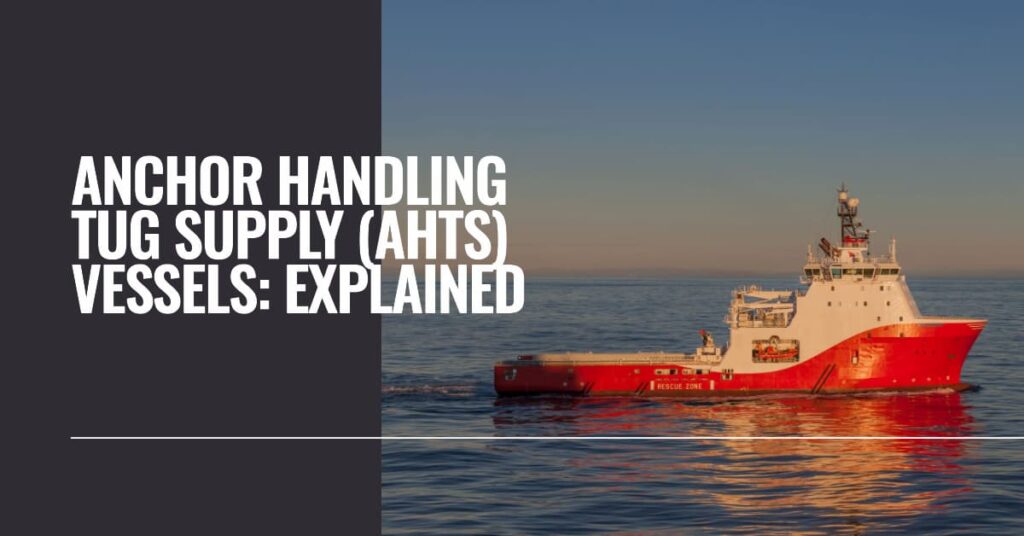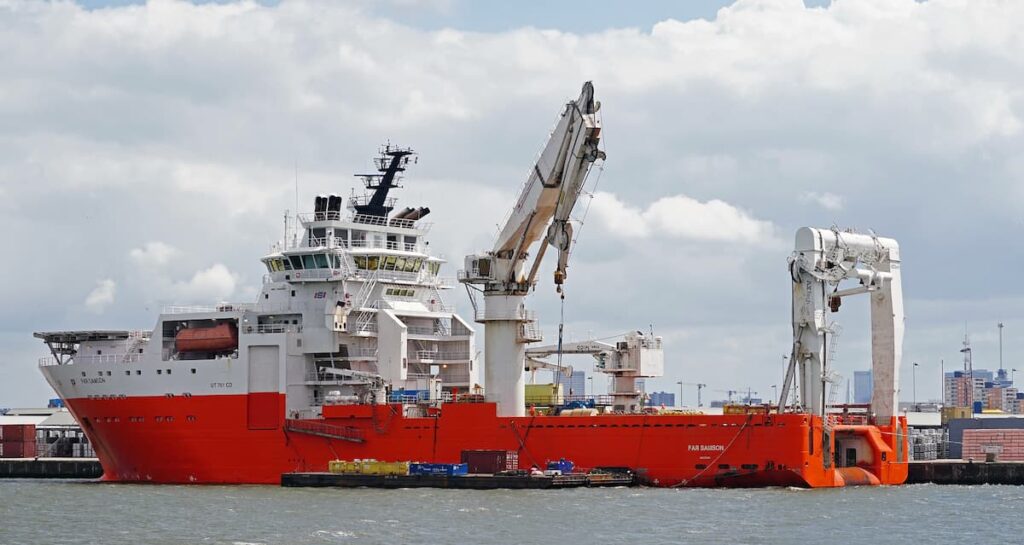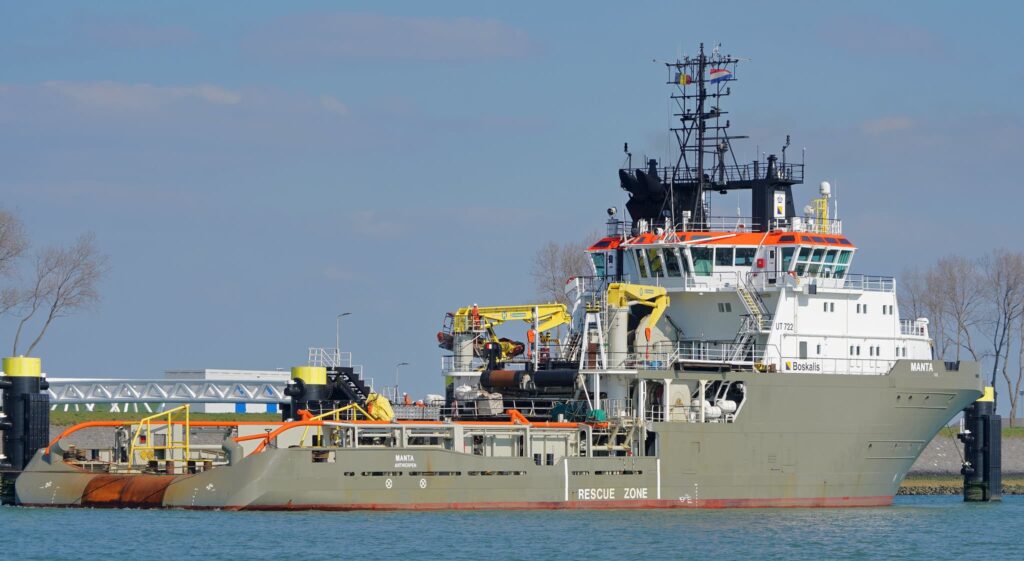“What are Anchor Handling Tug Supply (AHTS) vessels?” This question is fundamental to understanding modern maritime operations.
Anchor Handling Tug Supply vessels (ship prefix: “AHTS”), integral to offshore industries, offer crucial support for anchor handling and cargo delivery. Their role extends far beyond just towing and supply, acting as the backbone for many offshore tasks.
Recognizing their importance and diving into their multifaceted operations provides a deeper appreciation for maritime activities.

3 Key Takeaways:
- Evolution and Purpose: AHTS vessels have a rich history that aligns with the needs and advancements of the maritime industry, underlining their essential role.
- Key Features: Beyond their primary tasks, the technicalities and features of these vessels make them indispensable, from towing capabilities to safety measures.
- Modern Maritime Role: In the current maritime landscape, AHTS vessels not only support but often lead various operations, emphasizing their continued relevance and significance.
Introduction to Anchor Handling Tug Supply (AHTS) vessels
In the bustling realm of the maritime industry, Anchor Handling Tug Supply (AHTS) vessels stand out as the workhorses of the seas. Often navigating through the vast expanse of offshore territories, these specialized ships are far more than their technical name suggests.
Anchoring the colossal oil rigs, ensuring supply operations run seamlessly, and the sheer power to tow significant structures – it’s all in a day’s work for these remarkable vessels.
While the offshore industry thrives on oil extraction and exploration, the AHTS boats provide much-needed support, bridging the gap between onshore facilities and deep-sea ventures.

But what makes them so indispensable? Their design is built for resilience, and their capabilities, are molded for efficiency.
Whether you recognize them as AHTS ships, AHTS boats, or simply as Anchor Handling vessels, one thing remains clear: their undeniable significance in the world of offshore operations.
As you delve deeper into the maritime world of nautical science, shipping, and naval architecture, the AHTS vessels emerge as the unsung heroes, ensuring the safety and efficiency of the broader shipping ecosystem.
Evolution and Purpose of AHTS Vessels
Diving into maritime history, we encounter a myriad of vessel types, each sculpted by necessity and refined by technological advances. Among these, the rise of Anchor Handling Tug Supply ships offers a captivating glimpse into human ingenuity in meeting maritime challenges.
Before the dawn of the AHTS, maritime operations had a distinct separation between tugboats, supply vessels, and anchor handlers. However as offshore exploration, especially in the oil industry, expanded its horizons, a unique challenge emerged.
How could these remote sites, often in hostile seas, be serviced efficiently and safely?

Enter the development of Anchor Handling Tug Supply ships. These vessels, born from a synthesis of various functionalities, emerged as a response to this growing demand.
By combining the strength of tugboats, the dexterity of anchor handlers, and the efficiency of supply vessels, the AHTS provided an all-in-one solution to the oil industry’s maritime needs.
With each passing decade, the AHTS vessels underwent transformations. From their rudimentary beginnings as mere support vessels, they’ve evolved into technologically advanced giants, crucial for modern offshore operations.
As maritime operations progressed and the waters charted grew more challenging, so did the capabilities of these historical vessels.

Key Features of AHTS Vessels
Delving into the world of Anchor Handling Tug Supply vessels, it becomes abundantly clear that these aren’t your everyday boats. Sculpted meticulously with an arsenal of technical features, they are equipped to handle the most demanding maritime challenges.
Their design, a perfect confluence of functionality and resilience, stands testament to human ingenuity.
From the contours of the ship design to their internal machinery, every element of the AHTS design is purpose-built. But what are these defining characteristics? What makes these ships the maritime marvels they truly are?
Towing and Anchor Handling Capabilities
At the heart of an AHTS vessel lies its robust towing and anchor handling equipment. These are not just regular tugboats; their prowess goes beyond.
Outfitted with powerful winches and specialized gear, they can handle anchors for oil rigs, especially during challenging anchoring in deep water operations.
To illustrate, consider a notable AHTS operation in the North Sea, where a vessel successfully anchored an oil rig amidst turbulent waters, showcasing the epitome of tug operations and anchoring techniques.
This exemplifies the extraordinary AHTS towing capabilities, ensuring that maritime tasks, however complex, are executed seamlessly.
Supply and Cargo Handling
While their name predominantly hints at anchor handling and towing, AHTS vessels play a pivotal role as offshore supply vessels too. They ensure that offshore installations, often isolated and distant, never run short of essential supplies.
Whether it’s machinery parts, food, or technical equipment, these ships are the lifelines that keep offshore rigs operational.
Thanks to a meticulously planned design, AHTS cargo sections boast ample space and state-of-the-art load-handling systems. This means they can transport vast amounts of goods, tailored to the unique needs of each maritime supply request.
From the bustling harbors to the serene vastness of offshore rigs, these vessels ensure that supply chains remain unbroken and efficient.
Role of AHTS in Modern Maritime Operations
In an era where the maritime landscape is continuously evolving, the Anchor Handling Tug Supply vessels remain a steadfast presence, adapting and thriving amidst the flux.
While their origins may be traced back to earlier days of maritime exploration, their role in modern shipping and offshore operations has only amplified. The versatility and robustness of these vessels have ensured they remain an invaluable asset in today’s maritime industry.
With the onset of technological advancements and new maritime trends, the AHTS vessels have reshaped their operations.
As modern shipping operations grow more complex, the demands on these vessels have shifted, broadened, and intensified. But how exactly do they fit into the puzzle of current maritime trends?
In today’s maritime world, there’s an unequivocal emphasis on safety. And in this context, AHTS vessels shine brightly. Outfitted with cutting-edge navigation systems, they traverse the waters with unparalleled precision.
But it’s not just about getting from point A to B; it’s about doing so while adhering to the stringent maritime regulations that ensure vessel and crew safety.
These regulations, continuously updated to reflect the needs of the times, demand impeccable navigation techniques. And AHTS vessels, with their superior design and equipment, rise to the occasion every time. Whether navigating through treacherous waters or managing complex anchoring operations, their commitment to maritime safety remains unwavering.
Incorporating the latest in safety protocols, from automated alarm systems to advanced firefighting equipment, AHTS vessels underscore the industry’s commitment to safe operations.
Every voyage, every operation, is a testament to the delicate balance they maintain between duty and safety, solidifying their role in the modern maritime tapestry.
Notable AHTS Vessels and Operations
The maritime industry has seen various vessels, but few stand out as remarkably as certain Anchor Handling Tug Supply (AHTS) vessels. These vessels have not only showcased exemplary performance but have also been part of significant maritime operations that marked milestones in the industry.
Far Samson
Far Samson, owned by Solstad Offshore, is one of the most powerful AHTS vessels ever built. In 2009, this vessel was awarded the Ship of the Year title by Skipsrevyen, a Norwegian maritime magazine.

Far Samson is recognized for its multi-role capabilities, including subsea construction and installation apart from traditional anchor handling and supply functions. With a bollard pull of more than 400 tons, its power is unparalleled in AHTS classifications.
Maersk Lancer
A part of the vast fleet owned by Maersk Supply Service, the Maersk Lancer has played a significant role in various offshore operations.

This vessel is known for its versatility, and its deepwater operations have been pivotal in oil exploration and drilling activities in regions like the North Sea.
Operations in Deep Waters
AHTS vessels are regularly involved in deepwater operations, aiding in anchoring massive oil rigs in depths previously considered unfeasible. They play a vital role in regions like the Gulf of Mexico and offshore Brazil, where deepwater drilling has become the norm.
Their involvement ensures that these rigs remain stable, even in challenging conditions, marking significant AHTS operations in maritime history.
These vessels and operations underscore the pivotal role that AHTS vessels play in the maritime world. Their achievements are not just in their specifications but in the real-world operations where they prove their mettle.
In Conclusion: Understanding the Unyielding Spirit of AHTS Vessels
The maritime realm is ever-evolving, with vessels and operations adapting to the shifting tides of time. Amidst this change, Anchor Handling Tug Supply (AHTS) vessels stand as a beacon of constancy and adaptability. These vessels, designed with precision and fortified with robust features, play an indispensable role in the maritime sector.
From their unparalleled towing and anchor handling capabilities to their role in ensuring safe navigation and offshore supplies, AHTS vessels serve as the backbone of many modern maritime operations. As showcased through notable AHTS operations and vessels, their impact on the industry is profound and undeniable.
While there are numerous vessels sailing the vast expanses of the world’s oceans, AHTS ships, with their unique blend of technical prowess and versatility, leave an indelible mark.
As the maritime industry progresses, these vessels will undoubtedly continue to be at its forefront, anchoring operations and steering the path forward. For those intrigued by the intricacies of the maritime world, understanding the role and significance of AHTS vessels is paramount.
Remember, in the vast tapestry of maritime operations, the Anchor Handling Tug Supply vessels are the threads that often bind the narrative together, making them not just ships but symbols of maritime excellence.
- Types of Gas Carriers as per IGC Code – April 22, 2025
- Wind-Assisted Propulsion Systems (WAPS): A Game Changer for Maritime Decarbonization – February 6, 2025
- 10 Boat Salvage Yards in California – January 25, 2025





